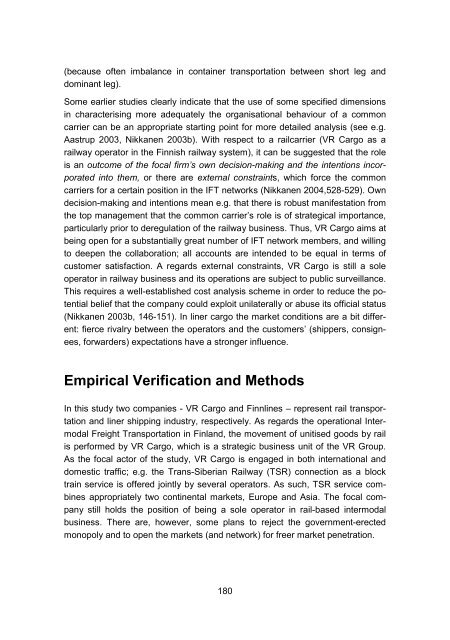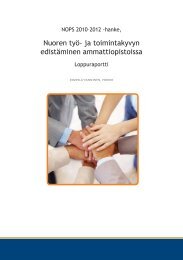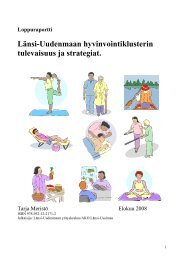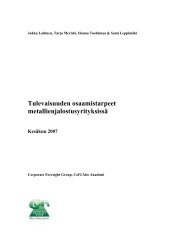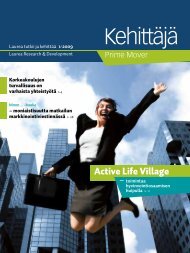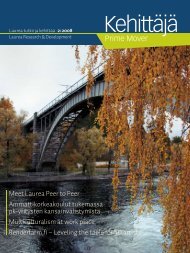849954 sisus
849954 sisus
849954 sisus
Create successful ePaper yourself
Turn your PDF publications into a flip-book with our unique Google optimized e-Paper software.
(because often imbalance in container transportation between short leg and<br />
dominant leg).<br />
Some earlier studies clearly indicate that the use of some specified dimensions<br />
in characterising more adequately the organisational behaviour of a common<br />
carrier can be an appropriate starting point for more detailed analysis (see e.g.<br />
Aastrup 2003, Nikkanen 2003b). With respect to a railcarrier (VR Cargo as a<br />
railway operator in the Finnish railway system), it can be suggested that the role<br />
is an outcome of the focal firm’s own decision-making and the intentions incorporated<br />
into them, or there are external constraints, which force the common<br />
carriers for a certain position in the IFT networks (Nikkanen 2004,528-529). Own<br />
decision-making and intentions mean e.g. that there is robust manifestation from<br />
the top management that the common carrier’s role is of strategical importance,<br />
particularly prior to deregulation of the railway business. Thus, VR Cargo aims at<br />
being open for a substantially great number of IFT network members, and willing<br />
to deepen the collaboration; all accounts are intended to be equal in terms of<br />
customer satisfaction. A regards external constraints, VR Cargo is still a sole<br />
operator in railway business and its operations are subject to public surveillance.<br />
This requires a well-established cost analysis scheme in order to reduce the potential<br />
belief that the company could exploit unilaterally or abuse its official status<br />
(Nikkanen 2003b, 146-151). In liner cargo the market conditions are a bit different:<br />
fierce rivalry between the operators and the customers’ (shippers, consignees,<br />
forwarders) expectations have a stronger influence.<br />
Empirical Verification and Methods<br />
In this study two companies - VR Cargo and Finnlines – represent rail transportation<br />
and liner shipping industry, respectively. As regards the operational Intermodal<br />
Freight Transportation in Finland, the movement of unitised goods by rail<br />
is performed by VR Cargo, which is a strategic business unit of the VR Group.<br />
As the focal actor of the study, VR Cargo is engaged in both international and<br />
domestic traffic; e.g. the Trans-Siberian Railway (TSR) connection as a block<br />
train service is offered jointly by several operators. As such, TSR service combines<br />
appropriately two continental markets, Europe and Asia. The focal company<br />
still holds the position of being a sole operator in rail-based intermodal<br />
business. There are, however, some plans to reject the government-erected<br />
monopoly and to open the markets (and network) for freer market penetration.<br />
180


